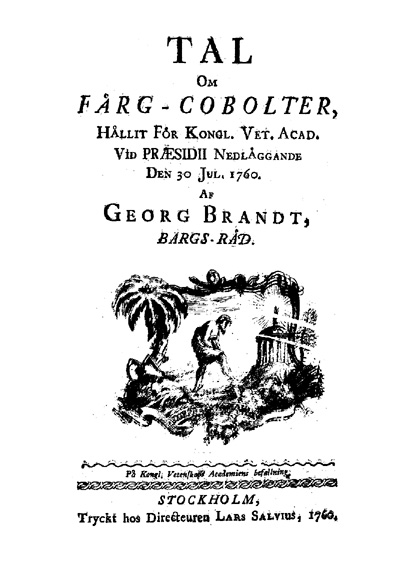BRANDT, Georg.
(1694 – 1768)
Brandt was educated under Boerhaave in Leiden, The Netherlands, receiving his M.D. in 1726. In 1727, he became director of the chemistry laboratory of the Swedish Bureau of Mines. Appointed the warden of the Stockholm mint in 1730, Brandt was later appointed professor of chemistry at the University of Uppsala. He was the first to produce accurate researches on arsenic and to discover zinc in calamine (now smithsonite). He distinguished between potash and soda in 1746.
Biographical references: Almquist, Bergskollegium, 1909: p. 178. • Bergman, T.O., Åminnelsetal öfver Georg Brandt. Stockholm, 1769. • DSB: 2, 421-2 [by U. Boklund]. • Mayerhöfer, Lexikon der Naturwissenschaften, 1958-75: p. 546-7. • Oseen, C.W., "En episod i den svenska kemiens historia", Lychnos, 1940, 73-85. [Concerns Brandt's 1748 discovery that gold dissolves in Aqua-Rega acid]. • Partington, History of Chemistry, 1961-70: 3, 168-9. • Poggendorff: 1, col. 280. • SBA: Scandinavian Biographical Archive: B-034, 287-288; B-034, 310. • Svenskt Biografiskt Handlexikon: 1, 131. • Svenskt Biografiskt Lexikon: 5, 788-9. • WBI. • World Who's Who in Science: 231.

1. Swedish, 1760 [First separate edition].
Tal | Om | Fårg-Cobolter, | Hållit För Kongl. Vet. Acad. | Vid Præsidii Nedlåggande | Den 30 Jul. 1760. | Af | Georg Brandt, | Bärgs-Råd. | [vignette] | [wavy rule] | På Kongl. Ventenskaps Academiens befallning. | [ornate rule] | Stockholm, | Tryckt hos Directeuren Lars Salvius, 1760.
8°: A8 B4; 12l. [1]-24 p. Title-vignette, head- and tailpiece, initial.
Contents: [1-2], Title page, verso blank.; [3]-22, Text.; 23-24, "Svar, | Gifvet på | ... | Min Herre!"
Rare. By roasting what at the time was called Swedish pyrite (mineral: linnaeite), Brandt obtained a black powder, which he further reduced with charcoal powder and fluxes in the intense heat of a forge with bellows. The result was a compact mass with a reddish tint that was magnetic, malleable and of high melting point. This is the first separate publication announcing Brandt's discovery of the element cobalt, describing the process of reducing the metal.
Bibliographical references: BL [965.k.2.(5.)]. • Jonathan Hill, Bookseller: cat. 43, no. 46. • LKG: XVI 321. • Partington, History of Chemistry, 1961-70: 3, 168-9.
.